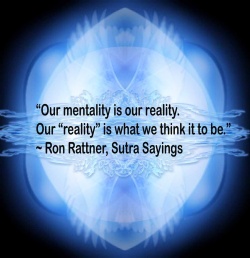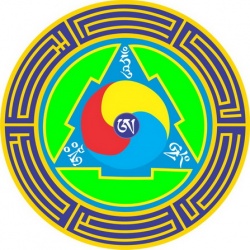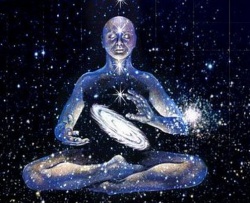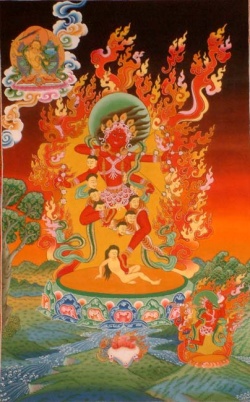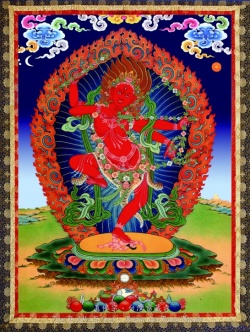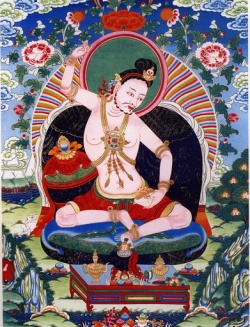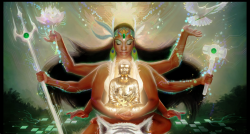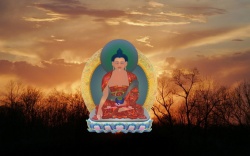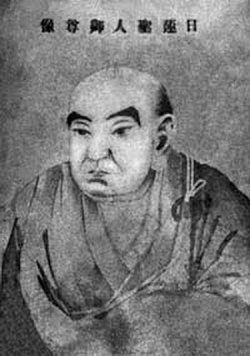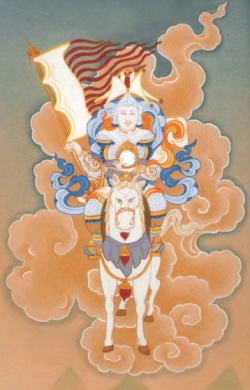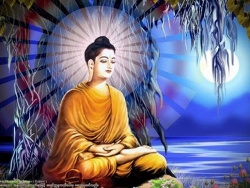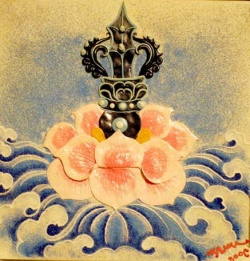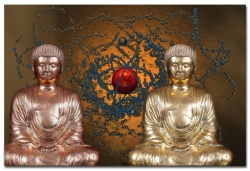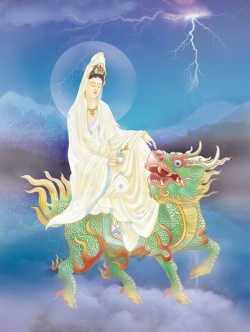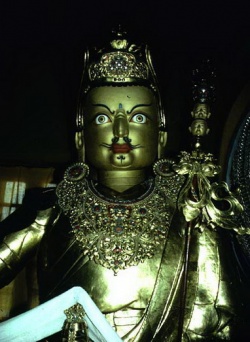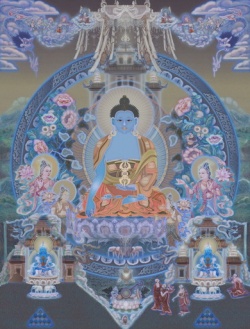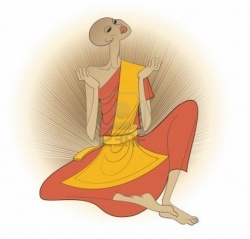The Four Seals
First I would like to express my greetings and regards for all of you present here today. I am delighted at your being here, especially those of you who have arranged this course and those who have prepared your spiritual path with a certain amount of study, listening, and reflection that has given rise to faith. Not blind faith, but faith based on analyzing and investigating Buddha’s teachings.
All sentient beings, and in particular human beings, long for and search for happiness and joy. From the perspective of Buddhism and the teachings of Buddha, joy is twofold, mental joy and physical joy. Of these two, mental joy is more important since it can give rise to physical joy.
The enlightened being known as Buddha has revealed numerous enlightened teachings to grant us happiness and inner peace. Whether these teachings are a cause for experiencing deeper and more profound levels of inner peace depends on our ability as individual seekers and practitioners to scrutinize and analyze the teachings, and validate them in our own existence.
The teachings given by Buddha are infinite in number, but can be summarized in what is called The Four Seals. Since some of you attending this talk seem to be new to the teachings of the Buddha, I would like to present a summary of these teachings in the context of the seals.
Generally, all experiences can be classified into external phenomenal experiences and internal phenomenal experiences. What do we mean by internal phenomenal experience? All the phenomenal experiences that are experienced by our mind are referred to as internal phenomenal experience. And what do we mean by external phenomenal experience? External phenomena are defined as the inanimate objects or matter not embraced by a stream of consciousness as opposed to internal phenomena which are embraced by consciousness. This is the prime definition.
Whether there is an internal phenomenal existence or experience or an external phenomenal existence or experience, all phenomenal experiences or existences come into being through the aggregation or the composition of many causes and conditions. If phenomena are produced by these combinations of causes and conditions, Buddhism asserts that these phenomena are also subject to change and impermanence, precisely because the phenomena are only collections.
The impermanence that pertains to both internal and external experiences is twofold-- subtle impermanence and gross impermanence. Most of us understand the changes caused by the gross aspects of impermanence. Such changes are changes of weather during the four seasons, changes of material objects, and changes of physical existence when experiencing illness and pain, and so forth. All these substantial changes that take place are regarded as the gross aspect of impermanence. Just why is it important to understand the gross form of impermanence as it relates to all kinds of phenomenal experience? Let’s say, for example, that we possess some gross material property. If that possession is embraced by the understanding of impermanence applied to the property itself, we are able to enjoy and utilize the possession of our property without falling victim to that property or possession if it is separated from us. On the contrary, if we try to indulge our self with our physical possessions without an understanding of the impermanence of these passions, then grasping at the permanence of these objects will create a contradiction between our state of mind and the object, whose basic nature is impermanence. When the object is then broken or lost, we will become victims.
So, if we genuinely try to understand the teachings of the Buddha on impermanence, then no matter what kind of social status we belong to, even if we are very wealthy and have good looks, pride and arrogance, a sense of clinging onto self or ego will not develop because we understand the law of impermanence that applies to all phenomenal experiences, such as wealth, good looks and so forth. In the same manner, we will not develop a sense of contempt of other sentient beings. To the contrary, an individual who has contemplated the teachings of the Buddha on the law of impermanence will begin to develop a sense of closeness and concern and respect for all forms of living creatures.
Additionally, if you have a partner, and if you bring the understanding of impermanence into that sexual relationship, the relationship will be enhanced by understanding the law of impermanence rather than letting the relationship deteriorate. So the understanding of impermanence actually enhances the relationship even on that level. Why? Because if you cultivate the understanding of impermanence within your mind while having a relationship with a sexual partner, you will value the other person and respect the relationship itself, and you will try to contribute to that relationship to the best of your ability to improve the relationship. You are aware that the law of impermanence can come at any moment and interrupt that relationship. So before the law of impermanence shatters the relationship, one can decide to live the totality of the life in connection with that relationship. One of the Buddhist mystics has said that “The family members are as well embraced by the law of impermanence. They will all experience the law of impermanence, the law of change. The gathering of the family members and relatives is like a gathering of a crowd in the market place. The crowd can disperse and part at any moment.”
Thus, if you familiarize yourself with the understanding of the law of impermanence, as the Buddha taught, you will definitely attain a transformation that will give you the experience of inner peace. This is also my personal experience.
The second aspect of impermanence, subtle impermanence, is as the name suggests, very difficult to detect and understand. Take, for example, my body. When you observe me talking to you, you are not able to observe the minute changes occurring within my body. These minute changes constantly occur moment to moment and are referred to as subtle changes or subtle impermanence. We are deluded by our perceptions because we are not able to detect these changes, and our observations do not correspond with the subtle changes that are constantly occurring on the physical level. My body is just an example. The concept could also be applied to each and every inner and outer phenomenal experience an individual goes through.
There exist no exceptional phenomenal experiences that are not subject to the minute changes that occur moment by moment. The first moment cannot last, and is superseded by the second moment, and the second moment by the third, and so on. There seems to be no entity that can remain totally fixed and unaffected by subtle changes.
So, if we were asked who can perceive these minute moment to moment changes, referred to as subtle impermanence, ordinary individuals will usually not be able to understand or detect these subtle changes intuitively. However, those who are spiritually developed are capable of detecting and understanding the subtle changes that are occurring within and without.
In addition, it seems that scientists can observe parts of these subtle changes. Maybe they are not able to detect the overall nature or totality of the subtle changes, but when it comes to grasping the minute changes, they are able to do so.
For example, we can draw upon the examples of the flame and river to establish this concept. The flame seems to the conventional eye to be a singular phenomenon, as does the river. But the fact is that neither the flame nor the river is a singular phenomenon. There is constant change occurring within that flame as well as within that river. The flame that is produced in one instant is exhausted in the next. Similarly, for the individual the flow of the river seems singular and independent, but the truth is that lasts year’s river has gone far, far away, replaced now by so many new rivers. We are not able to see the minute constant changes that are occurring within the body of the river or the body of the flame because the gaps between the instants of different flames and the instants of different rivers or any other phenomenon are so minute and ongoing.
To illustrate ordinary wisdom or the wisdom possessed by ordinary beings, and superior wisdom or the wisdom possessed by highly evolved spiritual beings like bodhisattvas, we can use two examples. To illustrate ordinary wisdom, we can use the analogy of the hand. To illustrate superior wisdom, we use the example of the eye. The difference between ordinary and superior wisdom is like the difference between the eye and the hand. If you place a single hair in the palm of your hand, you will not be able to feel the sensation. But if you place that single hair into your eye, you will immediately feel the sensation – and it will be an intense sensation. The wisdom of highly evolved spiritual beings is sensitive like the eye. They are able to perceive and detect not only the grosser level of impermanence or change, but also the subtle level of impermanence or change. Somebody who has attained such sensitive wisdom, such vulnerable wisdom, is capable of enjoying each and every possession, without falling victim to any of these possessions; whereas an individual with ordinary wisdom will at some point fall victim of the possession.
Suffering comes about because our state of mind, or our attitude or perspective, does not correspond or is not similar to the situation, external object, or phenomenon. The true nature of the appearance is that of change, but our attitude is only one of clinging to permanence and static phenomena. Because of our misinterpretation, our attitude toward any phenomenal experience will not correspond to the true nature of that experience, and that non-correspondence becomes the cause of pain and suffering.
Up to this point we have talked about the first seal, impermanence. The first teaching that Buddha gave with regard to The Four Seals was that all phenomenal existence or phenomenal experiences are impermanent and subject to change. The second seal that Buddha explained was that all contaminated phenomenal experiences are subject to pain. Whatever defiled phenomena, polluted, or contaminated phenomenal experiences our minds are occupied with becomes an occupation of conceptual and superstitious thoughts that will prevent us from further spiritual development. We can say that these experiences “pull us down.” The exact definition of the expression defiled phenomena is the experience when our mind is occupied with thoughts and emotions and then causes our minds to deteriorate.
The different defiled phenomena are numerous, but we can draw here on just one example the defiled phenomena of anger or aggression. For example, if we as Buddhist practitioners give rise to an emotion of intense anger and aggression, then we should view the emergence of such a complex of emotional anger and aggression as very negative and destructive for our self and others. Because of the negative consequences, it is a mistake or a fault to allow our self to give rise to such destructive emotional complications.
We can be someone who possesses good looks, but the very moment we give rise to very intense emotional anger or aggression, we can no longer be defined as a beautiful person. A mind that is occupied with some kind of ugly state of being will affect the appearance of the body as well. Not only is the physical appearance of such a person changed, but also the speech is affected, and communication with others will be unfruitful, even very destructive and negative. So whenever we give rise to the emotional thought of intense anger or aggression, we should try to utilize the mental factor known as mindfulness or awareness and catch hold of the emotion of anger. We should also work to understand that the true nature of this emotion as not good or constructive. It is destructive. This knowledge alone will inspire us to do away with negative emotions, such as anger and aggression. This is precisely the reason why the second seal states that all defiled phenomenal experiences bring pain and suffering.
The third seal was expressed by the Buddha as “All phenomenal existence and experience is empty as well as empty of self.” All phenomenal experiences can be summarized by five psycho-physical aggregates: Form, feelings, perceptions, mental formations, and consciousness. These five psycho-physical aggregates are empty of personal self. There is no personal self that can be found in the basis of the five psycho-physical constituents or existence. By grasping onto the notion of a self, the person will actually support defiled phenomenal experiences.
In Tibet, there is an expression or saying that says if you hear a loud noise created by falling water, you can be certain that the water must have hit something hard. Similarly, if there are a lot of psychological and emotional complications in our minds, there must be some substance from which all this inner noise is produced. This substance is called grasping onto the notion of the existence of a self or a person. If there is a big gathering and we can hear a shout, we can assume that there must be somebody behind this shouting. Similarly, there must be some kind of fundamental force behind all psychological complications. This force is regarded as the belief in the notion of a self.
If we have given rise to the emotional complication of anger, we should immediately scrutinize or question this anger. Who is the one actually experiencing this anger? Who is producing this anger? Toward whom is the anger directed? Look into your self as someone who has given rise to the thought of anger and try to find out if as an individual who has given rise to this thought, you exist independently as a self. In a similar manner, inquire also into the objects the anger is directed at. Does this object or person exist naturally as an independent entity? If you reflect in this manner when you give rise to the thought of anger, the impact of the thought of anger will be lessened immediately. The reason is because there does not exist an entity known as the self of the person that gives rise to the anger.
We are very familiar with the concept of a self. Usually when we say “I” this is similar to positing the existence of a self, but we have to inquire into the efficacy of this concept. Where does this self exist? Does it exist in your body or in connection with your body? Or does it exist in your mind or in connection with your mind? Try to analyze further whether the self of the person is exactly the same as the body or completely separate from the body. If the self of the person is posited on the basis of your physical existence, then your physical existence is manifold in the same way as you have several limbs. So there arises a difficulty when you posit the existence of a self on the basis of physical existence. You may then assert that the self is not identical to your body, but is something completely different from the body. This conclusion also creates difficulties because you cannot pinpoint a separate existence of the self of a person other than the physical appearance of the person itself. Similarly, you can apply the same reasoning not only to your body, but also to your consciousness.
This form of reasoning is called the reasoning of identity and non-identity. Applying the same reasoning to your mind, you will discover that there exists no self which is the same as your consciousness nor does there exist a self which is different from your consciousness. In this manner we can prove that the self of the person does not exist in connection with your body or in connection with your mind. Yet there still exists a conventional self which experiences joy and happiness and pain and suffering. So the concept is a little bit like saying the self does not exist, but there exists something else which actually experiences all this happiness and suffering.
Dream experiences obviously do not exist other than as mental projections of the person dreaming. So while you are dreaming and experiencing, all kinds of dream appearances occur. If you are capable of recognizing your dream at that moment, you are having a lucid dream, and you will not take the dream as a reality and, therefore, be liberated from nightmarish dreams. Because of this insight into the true nature of the dream, you are liberated from the notion of taking the dream as a reality. So if you give rise to insight into the emptiness of the self or the emptiness of the self of the person and base your activities on this idea, then none of your activities will cause any form of suffering, but instead cause pure joy and peace.
The fourth seal as spoken by the Buddha is “nirvana is peace”. The term nirvana in Tibetan can be translated as “transcending suffering.” The difference between Buddha Shakyamuni, who transcended beyond the suffering, and those who have not done likewise and are still submerged in the suffering of cyclic existence, samsara, is very small. The difference is that of mistakenness and non-mistakenness. One of the famous teachers of Tibetan Buddhism, Lonchen Rabjam, has given an example of this difference in one of his important writings. He asks us to imagine a very beautiful mansion occupied by two persons -- one possessing supernatural perception, the other completely asleep. The person sleeping is actually experiencing a very complicated dream, and because of this dream, the person experiences all kinds of suffering. On the other hand, the person who sits next to him, who is not dreaming and is completely awake, is able to see everything that unfolds in the mind of the sleeping person. So the person who is not sleeping is in a very favorable situation; he is residing in a very beautiful mansion and surrounded by many beautiful objects. The person who is awake and possesses supernatural perception is a spiritual awakened being. The person who is fast asleep is a person who is completely unenlightened and residing in the wilderness of samsara.
This story illustrates that each and every being’s mind, whether we are enlightened or not, awake or completely asleep, is inherent with what is known as the Buddha potential. At any moment we can actualize this inherent nature. From the perspective of Buddhism, there is not a big difference between somebody who is enlightened and someone who is unenlightened. In terms of enlightened beings and unenlightened beings, unenlightened beings are beings who are taken more care of in Buddhism. Unenlightened beings are looked upon as someone to be cherished and taken care of, somebody to be looked after and be concerned about. A person who is awake will try his best to wake up the person who is asleep and going though all kinds of nightmarish dreams. The activity of the Buddha is nothing other than simply revoking the sleep, so we can wake up completely. Still, it is very difficult for an enlightened being to awaken us or shatter our dreams because we are so deeply asleep.
For the person asleep in the very beautiful mansion, everything seems to be impure because of the inner turmoil. But for the person who is completely awake, there is no room for impure appearances because the person sees the suchness of the reality free from ignorance.
The first and second seals say that all composite phenomena are subject to change and that all defiled phenomena cause pain. These two seals establish the relative or conventional truth. The last two seals – that all phenomenal existence is empty and empty of self and that nirvana is peace – establish the ultimate truth. Here ends the presentation of the four seals. If you have any questions, please ask them now.
Q: If the mind is the instrument of our investigation, and our mind is constantly changing, how can we trust what we find?
Rinpoche: The true nature of your mind is not disturbing emotions. The mind can be occupied with such emotions, but these emotions are not its true nature. And our mind is not always occupied with disturbing emotions. The fundamental quality of our mind becomes more dominant when our mind is not subject to disturbing emotions. The fundamental quality of our mind is clarity and intelligence. These qualities can be utilized to look at the mind itself.
Q: Will an enlightened person view a natural catastrophe and a human catastrophe as being empty?
Rinpoche: An enlightened being experiences a natural catastrophe exactly the way I described earlier. Enlightened beings view the natural catastrophe to be empty of self. But to the human beings who are the victim of this catastrophe, the catastrophe is real. This sense of reality is because the person is still spiritually asleep. However, the enlightened being will develop a tremendous sense of loving kindness and compassion toward the persons who are experiencing such catastrophes.
Q: Do you mean that the enlightened being does not experience all the pain of a natural catastrophe?
The enlightened person is capable of seeing and feeling and sensing the suffering of each living sentient being. Like the previous example we looked at with the person who was sleeping and experiencing nightmares, the person who is awake will try to help the person who is asleep – help him to wake up. Here is where we can talk about the unity of compassion and emptiness. The enlightened person sees the selflessness of the person and the tragedy. At the same time his or her mind is full of compassion and concern.
Q: Is an enlightened person at the same time compassionate and detached?
In Buddhism, you can strive for personal liberation, or you can strive for what is known as universal liberation. Mahayana Buddhism is the pursuit of universal liberation. The intent is to liberate each and every being from their limitations. So, if you are someone who follows the first approach, you will become enlightened according to that tradition. But you will not be capable of helping others very much. As for helping yourself, you have already been helped by gaining individual liberation. With the second approach, not only are you able to help yourself; you are able to help many other beings in terms of liberating them from their conditions, weaknesses and so forth by revealing spiritual insight to them. There is a technical term that describes this state of universal liberation. It is called abiding neither in the extreme of nirvana or in the extreme of samsara. It refers to a complete and perfect state in which there is neither the extreme of pain nor the extreme of peace.
Insight into the selflessness of the person or phenomenon enables one to attain nirvana. When one then practices loving kindness and compassion, one achieves an altruistic state of mind that prevents one from remaining in the extreme of nirvana just to entertain the self. The enlightened being is drawn into helping the sentient beings and society.
Q: The Dharma says that a belief in a self is the root of our suffering and that this belief forms the basis of all the emotions. Can you explain how this belief actually comes about?
Rinpoche: Grasping onto the concept of a self comes about because of basic ignorance. Ignorance is not able to understand the selfless state of mind and phenomena. This fundamental ignorance will give rise to the defiled emotions that arise because of a distorted view of reality. You cannot dream if you cannot sleep, right? Similarly, if there is no basic ignorance, there will be no grasping of the self.
Q: So it is like what you said in the beginning, that the way that we see things and the way things are does not correspond. Is that where the trouble starts?
Rinpoche: There is the appearance, and there is the nature of things. We know the presumed appearance. As for the essence of the appearance, we don’t know it. The mind that is ignorant of the true nature of the essence of the appearance grasps onto the existence of a self.
Q: How does one come to this understanding?
To liberate yourself from samsaric pain, you should meditate on the selflessness of persons and phenomena. However, in order to liberate yourself from falling into the extreme of nirvanic peace, you should meditate on loving kindness and compassion. By practicing these two approaches of mediation you will be prevented from falling into either extreme.
Q: I am a psychologist, and I work with people in my every day life. One of my main tasks is to try to make people think in another way – another way of perceiving themselves and situations. One of the practices of psychology is to get to know one’s self. I have seen how difficult it is to do so. Many people are very frightened about getting to know themselves. So in a way they choose to be in a samsaric state and suffer, rather than going to the other side where they would be better equipped to deal with their suffering. If you have some good ideas about this concept/practice, I would like to hear them. Can you also comment on this aspect in relation to what you said about the third seal?
Rinpoche: The third seal states that phenomena are empty and void of a self. The emptiness of phenomenal existence should be understood, as the psycho-physical aggregates are empty of a self. There is no self to be found anywhere in or among these aggregates. If you want to effectively employ the selflessness of persons, then one should apply the seven stages of reasoning found in the Buddhist Middle Way School. The seven point logical reasoning is quite difficult to grasp because it is very subtle. It can be summarized into what I just talked about – the reasoning of identity and non-identity.
When we say “my head,” the immediate concept we get from the statement is the picture of a simple head. But if we analyze further, we cannot find such a single head. One is not able to discover, by such analysis, a single unitary autonomous independent head. The head is empty! Laughter.
Q: How does this example apply to the example you gave on aggression?
Rinpoche: It is quite easy to apply this example to the emotional complication of anger. If somebody says, “You are terrible!” your immediate reaction will be aversion and dislike for that person. The reason is because you still grasp the notion of self of the person. So instead of reacting with anger to this person, the person deserves compassion. This person has no understanding of the emptiness of the self of the person. The person is therefore completely ignorant of the reality, and on the basis of that ignorance, the person is saying something which is abusive to you. But if you understand emptiness yourself, you will see that the person deserves loving kindness and compassion.
Buddha said that since everything is empty, everything is interconnected. When one understands the emptiness of self, one can easily understand the interconnectedness of each and every phenomenon. Then one naturally appreciates others because a human being depends on others and the environment to survive. This is how the understanding of interconnectedness occurs. That understanding comes from the understanding of selflessness and gives rise to the altruistic mind, which will then take care of fellow human beings and the environment.
Q: Does this explanation mean that the anger will disappear because I have this interconnection and altruistic feeling?
Rinpoche: If you understand Buddha’s teaching on interdependence, than you will naturally be able to liberate yourself from emotional anger. If you give rise to anger and react to this anger, it will create consequences, and the consequences of anger are not necessarily pleasant, but usually rather destructive. Since our basic longing is to avoid pain and to experience peace, such an action is contradictory to achieving this fundamental longing. One will not then contribute toward something that will fulfill one’s basic longing. By reasoning and understanding in this way, anger will liberate by itself.
Q: You said that Buddha is constantly trying to wake us up. How can we help?
Rinpoche: You can help an enlightened being by being vulnerable. Another way of helping the enlightened being when the enlightened being tries to wake you up is to help other sentient beings. Still another way is not to resist when an enlightened being try to disturb your sleep.
Q: Can you understand “empty of self” as “empty of consciousness”?
Rinpoche: There is a huge difference between emptiness of consciousness and emptiness of self. By asserting emptiness of self, we do not mean emptiness of consciousness. But a person can wrongly perceive the piece of rope as a snake. This misperception came from the sense of self.
Q: I have difficulty understanding. On the one hand, you say that we should try and do away with all negative emotions, polluted states of mind and all that. But on the other hand, in meditation, are you not supposed to be open to these things?
Rinpoche: In order to suit the different needs of different beings, Buddha presented many different techniques such as sutra and tantra. The different way of relating to our emotions is the difference between the presentation of the teachings according to the sutra and the tantra tradition. According to the sutra tradition Buddha states that one needs to renounce disturbing emotions. However, according to the tantra tradition Buddha says that you do not need to renounce such emotions, that you can utilize their presence and transform them onto your spiritual path. If disturbing emotions or afflictive states of mind are embraced by the wisdom of the path, all disturbing emotions will be transformed and used as a benefit to one’s spiritual practice, according to the tantric presentation.
Q: Would you say that one of these approaches is easier than the other? It seems very tiresome to the entire time try to push such emotions away, like trying to be somebody I am not. It seems easier when I sometimes am able to relax with the negative emotions.
Rinpoche: There is no general answer to your question. I cannot say that this particular approach is suitable for you, or that another approach is not suitable. The different techniques were presented by the Buddha to suit the different mental dispositions, spiritual inclinations and diverse interests of all sentient beings. So we cannot generalize.
Generally, we regard something impure as something which is no good. By something impure I mean, for example, human or animal excrement. We do not like it. But if it is utilized skillfully and intelligently, this waste can be used as fertilizer to produce a good harvest. So within the tantric approach, if your disturbing emotion is embraced by intelligence, the disturbing emotions will act as effective manure and give rise to inner spiritual blossoming.
As an analogy, to defeat or subdue an external enemy, there are two methods one can use. One can kill the enemy, or one can win the enemy over. In the tantric teaching, one tries to win the enemy over.
Q: Is perhaps one reason that we have difficulty in realizing nirvana is that we are afraid or we don’t believe that it exists?
Rinpoche: The reason why nirvana seems to be very rare is because of how we approach nirvana. Obtaining nirvana is not impossible; it's our approach that is inadequate. Usually when we approach a spiritual path, we are not very honest with our approach. Even when we enter into meditation, we just want to experience some kind of mental pacification, so we can overcome our tension and become active in competing at work or school or in relationships. These are trivial goals, and such meditation will not bring us closer to enlightenment or the attainment of nirvana. Many people are interested in meditation because they experience a lot of tension in society. They just want to escape the confrontation of society. Such an attitude will not bring one closer to nirvana.
It is very important to precede meditation with contemplation of Buddha’s teachings. The contemplation of the teachings should be preceded by proper study and listening to provide a basis for our reflection. People who are young should emphasize the approach of listening and studying, and then later try to reflect and meditate. If one’s spiritual practice is conducted in this manner, it will definitely create wellbeing for one’s mind and the minds of others, and one will become able to perform beneficial activities. One should have a large scope of mind and try to embrace each and every living sentient being with loving kindness and compassion. One should not just aim to attain individual liberation – not only think about one self.
If there are no more questions, I’ll conclude this session. I’d like to thank each and every one of you who have made an effort to develop spiritually. Thank you for being here today. Tashi deleh!
Translated by Lama Changchub at Karma Tashi Ling Buddhist Centre, Norway

